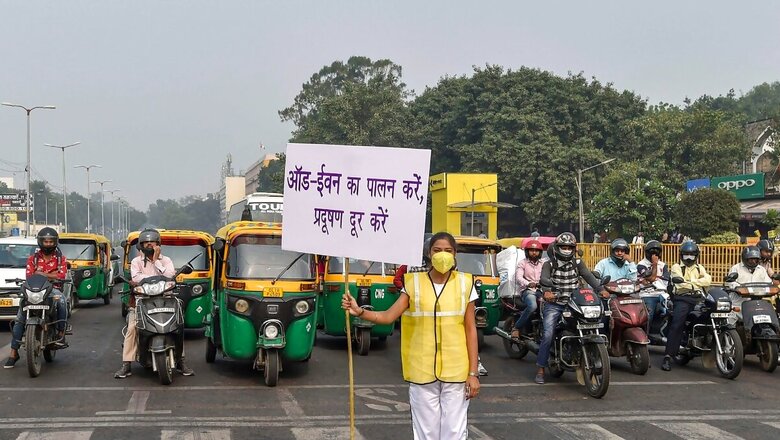
views
Given the alarming level of air pollution, the Delhi government on Monday announced that the odd-even rule for vehicles, which allows cars with only odd or even number plates to ply on a particular day, will be implemented in the national capital from November 13 to November 20.
The decision to impose the odd-even rule for cars was taken at a meeting chaired by Delhi CM Arvind Kejriwal deteriorating air quality. A meeting for implementation of the scheme will be held on Tuesday, Delhi Environment Minister Gopal Rai said.
What Is The Odd-Even Scheme?
The odd-even rule, which is applied only for private vehicles, allows cars with only odd or only even number plates to ply on a particular day. In simple terms, if your car carries an ‘odd-number’ registration plate, you will only be allowed to drive it on an odd day and vice versa for even days.
Those who fail to comply with the odd-even rule or violate the terms are charged a fine by the traffic authorities
Odd-Even Traffic Rationing Scheme: History
The odd-even traffic scheme was first introduced by Delhi Chief Minister Arvind Kejriwal in December 2016 as part of his government response to NCR’s breaching pollution levels, but it is not new to control vehicular pollution.
The scheme was first instituted in the US in 1979. The US used an odd-even scheme when unstable conditions in Iraq and Iran led to a worldwide increase in oil prices.
The scheme was used in the US again in 2012 after Hurricane Sandy. Gasoline became scarce, which led to fuel hoarding. License plates without numbers were considered odd.
Delhi Pollution: Does ‘Odd-Even’ Rule Help? Its Efficacy
According to an analysis by the Centre for Science and Environment (CSE), it is in this context that the government’s emphasis on public transport to curb pollution gains significance.
‘Odd-even’ was first introduced in 2016 by the AAP government to control vehicular pollution and bring down increasing particulate matter levels.
Studies and research done on its impact in Delhi often suggested positive results in terms of vehicular congestion and air pollution, however, the government has so far not released any concrete evidence on the impact of the policy.
According to a study done by Delhi Technological University (DTU) published in 2016, when the scheme was implemented for a roughly two-week period, the concentration of PM 2.5 and PM 1 saw a drop.
Energy Policy Institute at the University of Chicago (EPIC) and Harvard University also researched the impact of the odd-even rule in Delhi when it was first implemented. The study found that measures taken by the government in 2106 reduced the pollutants during the noon hours in Delhi.
The study also revealed that PM2.5 declined by 13% on average during the odd-even scheme.
Studies at IIT and IIM have shown a reduction in pollution in Delhi by 2-3% during the first phase of the Odd-Even scheme in 2016.
In the second phase of implementation, the Delhi government reported a 3% increase in metro ridership.
However, a report by CPCB (Central Pollution Control Board) told the NGT (National Green Tribunal) that “prima facie there is no data to suggest that odd-even scheme has any impact on the decrease in vehicular pollution…the fluctuations in PM10 and PM2.5 is due to weather and change in wind patterns."
Delhi Air Pollution Breaches ‘Danger’ Mark
The air quality has been severe in Delhi and neighbouring areas such as Noida, Ghaziabad, Gururgram, Faridabad etc., for the past few days, with no respite being seen anytime soon amid stubble burning and the upcoming Diwali festival, during which people are likely to burst crackers.
According to the data issued by the System of Air Quality Forecasting and Research (SAFAR-India), the air quality in the National Capital was recorded at 488, up from 410 a day ago.
The Air Quality Index (AQI) readings in RK Puram stood at 466, ITO at 402, Patparganj at 471, and New Moti Bagh at 488 on Monday morning.



















Comments
0 comment